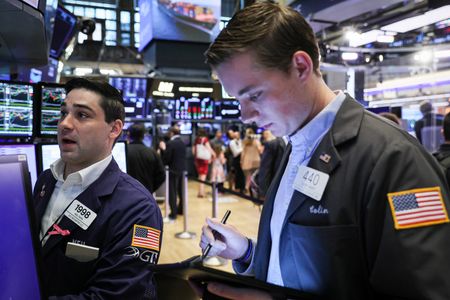A look at the day ahead in U.S. and global markets from Samuel Indyk.
Jerome Powell and his band of brothers on the Federal Open Market Committee will be sitting nervously.
At 0830 EDT (1230 GMT), the Bureau of Labor Statistics will release its latest consumer price data, which could go some way to determining what the Federal Reserve does with policy at its two-day meeting beginning Tuesday.
Markets are poised for the Fed to “skip” this month, after 10 consecutive rate hikes since March last year has seen its interest rate rise to 5-5.25% from 0-0.25%, the most aggressive series of hikes since the 1980s.
But first, inflation.
Economists surveyed by Reuters expect price pressures to have moderated last month, with the headline consumer price index falling to 4.1% on an annual basis from 4.9% the prior month. Core inflation is seen moderating to 5.3% in May.
“The big question from the CPI will be how it affects the Fed’s policy decision tomorrow,” said Deutsche Bank strategists led by Jim Reid.
Money market traders are pricing around a three-in-four chance the Fed keeps rates on hold and a one-in-four shot of a 25 basis point hike.
Another stubborn inflation reading could see a shift in expectations.
“Given there’s only a day to go, the fact that markets are still pricing in a non-trivial likelihood of a June hike shows that they’re not ready to discount the probability of a move just yet,” Reid and co. said.
For now, U.S. markets are in a buoyant mood.
The S&P 500 closed on Monday at its highest level since April last year and is up well over 20% from its October 2022 low – a bear market rally or a new bull market?
The narrowness of the rally has some questioning whether it can be the latter, as an-often common theme across bull markets is broad participation across sectors.
It’s no secret this rally has been driven mostly by large-cap tech stocks. An equal-weighted version of the S&P 500, which dilutes the impact of said stocks, is up just 3.1% in 2023, yet to recover to levels seen in March before problems emerged at U.S. regional banks.
European markets are still somewhat upbeat after the People’s Bank of China offered an overnight gift to bulls with a 10-basis point cut to its 7-day reverse repo rate.
That cut fueled speculation that longer-term rates could fall over the coming weeks to boost an economy that has stuttered as it reopened following some of the longest and toughest COVID restrictions.
Shares in the region welcomed the news, with MSCI’s broadest index of Asia-Pacific shares ex-Japan jumping over 1% to its highest since mid-April, while Japan’s Nikkei 225 closed above 33,000 for the first time in 33 years.
Key developments that should provide more direction to U.S. markets later on Tuesday:
* U.S. CPI, FOMC begins two-day meeting
* U.S. 30-year bond auction
(Reporting by Samuel Indyk; Editing by Susan Fenton)





